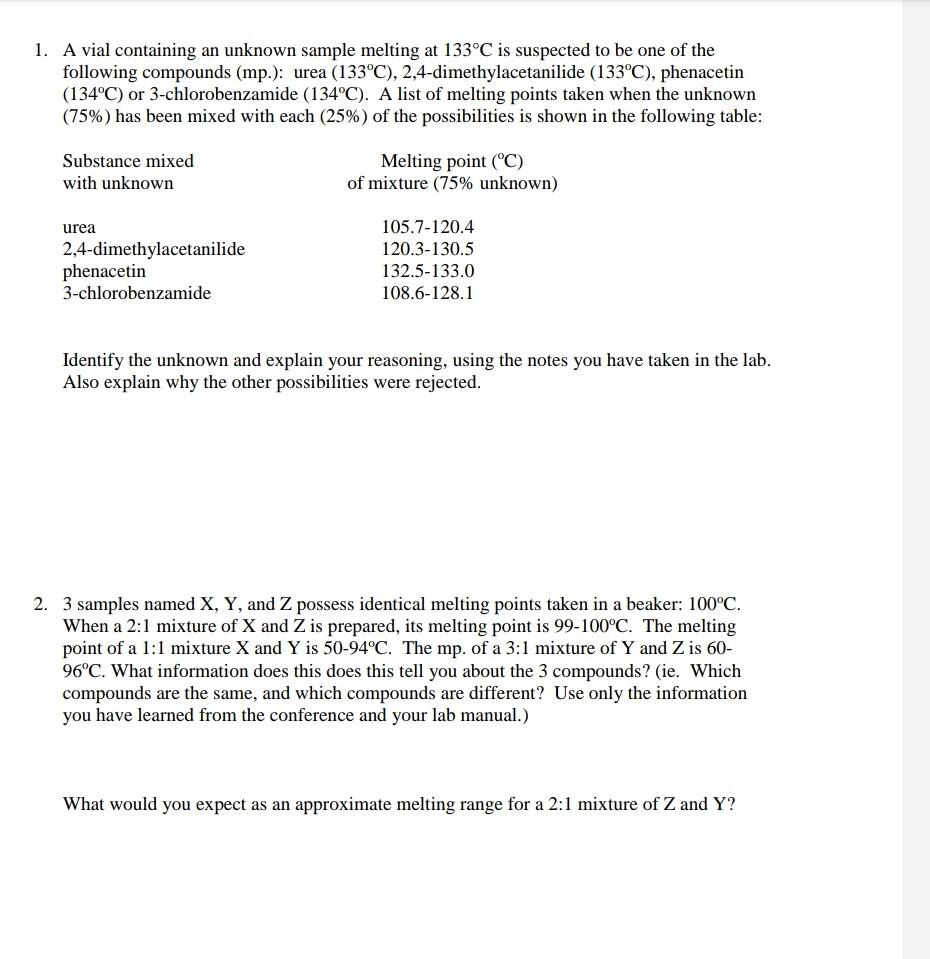Answered step by step
Verified Expert Solution
Question
1 Approved Answer
1. A vial containing an unknown sample melting at 133C is suspected to be one of the following compounds (mp.): urea (133C), 2,4-dimethylacetanilide (133C), phenacetin


1. A vial containing an unknown sample melting at 133C is suspected to be one of the following compounds (mp.): urea (133C), 2,4-dimethylacetanilide (133C), phenacetin (134C) or 3-chlorobenzamide (134C). A list of melting points taken when the unknown (75%) has been mixed with each (25%) of the possibilities is shown in the following table: Substance mixed with unknown Melting point (C) of mixture (75% unknown) urea 2,4-dimethylacetanilide phenacetin 3-chlorobenzamide 105.7-120.4 120.3-130.5 132.5-133.0 108.6-128.1 Identify the unknown and explain your reasoning, using the notes you have taken in the lab. Also explain why the other possibilities were rejected. 2. 3 samples named X, Y, and Z possess identical melting points taken in a beaker: 100C. When a 2:1 mixture of X and Z is prepared, its melting point is 99-100C. The melting point of a 1:1 mixture X and Y is 50-94C. The mp. of a 3:1 mixture of Y and Z is 60- 96C. What information does this does this tell you about the 3 compounds? (ie. Which compounds are the same, and which compounds are different? Use only the information you have learned from the conference and your lab manual.) What would you expect as an approximate melting range for a 2:1 mixture of Z and Y? 3. In olden days, when there were no refrigerators or availability of ice, ice cream was made by adding potassium nitrate to water to chill a container to -20C, making it possible to freeze the cream-sugar mixture. The container with the salt-water never froze, and remained as a liquid solution. Explain why no solid ice or slush was observed in this container, even though the temperature was well below 0, the freezing point of water. 4. When performing a melting point determination on a sample of cinnamic acid (mp. 136C), some particles of sand were present in the sample. What should you expect to see in the sample (with both sand and cinnamic acid in it) as it melts, and at what temperatures (approximately) these observations occur? (Heater only heats to 180C max) 5. Cinnamic acid and urea have the same melting point and dissolve in each other when melted. What should you expect to see as the sample (composed of 50% of each) melts, and what temperatures do you think (approximately) you should observe
Step by Step Solution
There are 3 Steps involved in it
Step: 1

Get Instant Access to Expert-Tailored Solutions
See step-by-step solutions with expert insights and AI powered tools for academic success
Step: 2

Step: 3

Ace Your Homework with AI
Get the answers you need in no time with our AI-driven, step-by-step assistance
Get Started


